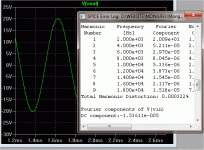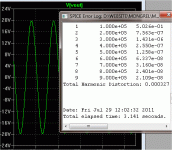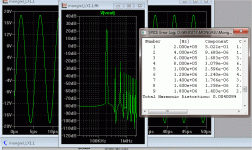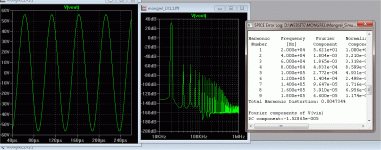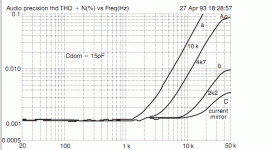ugly opamps
opamps are generally plastic encased 8pin devices in various shapes and sizes (standards).
Which versions are ugly?
opamps are generally plastic encased 8pin devices in various shapes and sizes (standards).
Which versions are ugly?
Hi,
you may want to replace that ugly op amp with a grounded base amplifier, but don`t expect much of a sound stage from CD-players.
You have obviously not listened to well-recorded CDs on a really good system.
Cheers,
Bob
Hi,
the conception of high-precision op amp meant for demanding industrial control applications in one convenient package has unreservedly been imported and adapted to audio along with the definition of signal transfer linearity. Very, very unfortunate.
the conception of high-precision op amp meant for demanding industrial control applications in one convenient package has unreservedly been imported and adapted to audio along with the definition of signal transfer linearity. Very, very unfortunate.
Which definition of "linearity" (apart from a straight line) should be used by the audio industry? A pleasant curve?
???? are "pleasant curves" ?? On a female,maybe ? 😀
Holman said of the APT1 amp " create the circuit with the best linearity - then apply NFB".
This works out ... 🙂 (below 1-2 ) same at 100k as 2k , no TMC, any load , simple circuit (APT-luxman-Cordell) PS - not a "blameless" - but better.
OS
Holman said of the APT1 amp " create the circuit with the best linearity - then apply NFB".
This works out ... 🙂 (below 1-2 ) same at 100k as 2k , no TMC, any load , simple circuit (APT-luxman-Cordell) PS - not a "blameless" - but better.
OS
Attachments
I didn't give this one to DIYA. Too many parts -139 😱
After carefully reading SYN08's OPS thread , any output stage issues are history.
Time to make the triple the "standard" around here for a high current linear AB amplifiers. It's a shame so many drive 5 or more BJT OP pairs w/ MJE based EF2's. The sanken to-3p BJT pairs are Ft 60mhz+/ 130-150Hfe/130W , actually better for either EF2 or 3. 2-4 pair is max for mje15032-33 drivers (my opinion)
OS
After carefully reading SYN08's OPS thread , any output stage issues are history.
Time to make the triple the "standard" around here for a high current linear AB amplifiers. It's a shame so many drive 5 or more BJT OP pairs w/ MJE based EF2's. The sanken to-3p BJT pairs are Ft 60mhz+/ 130-150Hfe/130W , actually better for either EF2 or 3. 2-4 pair is max for mje15032-33 drivers (my opinion)
OS
Amp starts to really decrease in output at 225khz. Still golden at 200k (.004%).
loss of 1 db here.
Input low pass filter is the most likely culprit.
Amp= luxman's green- led biased hawksford cascode , apt's diode clamps for controlled clip behavior, cordell's diamond triple with the sanken OP's as driver.
Higher Ft drivers and 10ma predriver bias make the triple stable even without the 150pf B-C driver stopper caps mentioned in SYN08's OPS thread. They are added regardless... to "make sure". Only 1 vbe - pre+ driver cancel perfectly on separate heatsink.
At 10 pair outputs/1R load , performance is similar. Perfect!!
PS - transient response is not as good as the LIN , only 40+ V/us. 🙁
OS
loss of 1 db here.
Input low pass filter is the most likely culprit.
Amp= luxman's green- led biased hawksford cascode , apt's diode clamps for controlled clip behavior, cordell's diamond triple with the sanken OP's as driver.
Higher Ft drivers and 10ma predriver bias make the triple stable even without the 150pf B-C driver stopper caps mentioned in SYN08's OPS thread. They are added regardless... to "make sure". Only 1 vbe - pre+ driver cancel perfectly on separate heatsink.
At 10 pair outputs/1R load , performance is similar. Perfect!!
PS - transient response is not as good as the LIN , only 40+ V/us. 🙁
OS
Attachments
Just wanted to address a common misconception about slew rate. It has very little to do with amplifier performance, including "speed". Slew rate is the amp operating in its non linear region. Its how fast the amp tries to recover from an input overload.
To test slew rate you hit the input with a large "instantaneous" voltage. This imediatley overloads the input ( the negative side of the input is still at zero, so the full input voltage is on the positive side).
The proper metric for amp speed is freq response, and 100khz is plenty fast for music.
Anyone who has recorded drums (the fastest instrument rise times (not including synths)) into a DAW can measure the rise times, there not that fast. Or play with an EQ till you find the freq that increases the drums "snap". Its usually 2k to 5k. No suprise its in the most audible region.
When will an amp ever put out full power at 20khz (or even 10khz) with music? Never (say goodbye to your tweeters), so even if the test its a good exercise it dosnt have much practical meaning.
To test slew rate you hit the input with a large "instantaneous" voltage. This imediatley overloads the input ( the negative side of the input is still at zero, so the full input voltage is on the positive side).
The proper metric for amp speed is freq response, and 100khz is plenty fast for music.
Anyone who has recorded drums (the fastest instrument rise times (not including synths)) into a DAW can measure the rise times, there not that fast. Or play with an EQ till you find the freq that increases the drums "snap". Its usually 2k to 5k. No suprise its in the most audible region.
When will an amp ever put out full power at 20khz (or even 10khz) with music? Never (say goodbye to your tweeters), so even if the test its a good exercise it dosnt have much practical meaning.
goodbye tweeters !!
Big power performance at 20k is just MM (mental masterbation). For music this amp just barely "sweats". Everything is easy for it.
The fact that it will do 1R at 200k just makes simple 20-10/20khz operation with 8R loads a "walk in the park". VERY FEW OEM's overdesign to this level , and if they do ... it'll cost you $10K. 😀
OS
Big power performance at 20k is just MM (mental masterbation). For music this amp just barely "sweats". Everything is easy for it.
The fact that it will do 1R at 200k just makes simple 20-10/20khz operation with 8R loads a "walk in the park". VERY FEW OEM's overdesign to this level , and if they do ... it'll cost you $10K. 😀
OS
Attachments
Amp starts to really decrease in output at 225khz. Still golden at 200k (.004%).
loss of 1 db here.
I guess this is more of a question. Does bandwidth limiting decrease THD readings? It would kinda make sense that in your amp any distortion over 200khz gets reduced by the LPF of the amp. But it probably depends where the filtering occurs, the input filter probably dosnt do it but the feedback network does and the Cdom filter effects only the previous stages. (I noticed some of these effects during sims which gave better HF THD than LF THD which didnt make sense) Just something to be aware of.
Just wanted to address a common misconception about slew rate. It has very little to do with amplifier performance, including "speed". Slew rate is the amp operating in its non linear region. Its how fast the amp tries to recover from an input overload.
To test slew rate you hit the input with a large "instantaneous" voltage. This imediatley overloads the input ( the negative side of the input is still at zero, so the full input voltage is on the positive side).
The proper metric for amp speed is freq response, and 100khz is plenty fast for music.
Anyone who has recorded drums (the fastest instrument rise times (not including synths)) into a DAW can measure the rise times, there not that fast. Or play with an EQ till you find the freq that increases the drums "snap". Its usually 2k to 5k. No suprise its in the most audible region.
When will an amp ever put out full power at 20khz (or even 10khz) with music? Never (say goodbye to your tweeters), so even if the test its a good exercise it dosnt have much practical meaning.
Slew rate is a metric that says how fast the amplifier output (or an internal node) can change in level. If your amp can deliver say 20VRMS at 20kHz it needs to have a slew rate of 4V/uSec (not sure of the exact value but it's close).
On te other hand, the freq response is a small-signal spec saying that, like, at 1V output, it falls off to -3dB at say 200kHz. Typically, you will find that at full power, the freq response is much less than 200kHz, because at those large levels, slew rate becomes the limiting factor. You can have a freq response of 200kHz and a slew-rate limited, large-signal bandwidth of say 50kHz.
Even if your amp will never have to deliver 20kHz at full power for an extended time, there are often large high-freq transients in music. If the slew rate is not sufficient, that transient will be severely distorted, even if your freq response is 200kHz.
So these are really two different specs that come into play in different circumstances. The real speed metric is slew rate: the unit already makes that clear: Volts per Time unit.
jan didden
Last edited:
I guess this is more of a question. Does bandwidth limiting decrease THD readings? It would kinda make sense that in your amp any distortion over 200khz gets reduced by the LPF of the amp. But it probably depends where the filtering occurs, the input filter probably dosnt do it but the feedback network does and the Cdom filter effects only the previous stages. (I noticed some of these effects during sims which gave better HF THD than LF THD which didnt make sense) Just something to be aware of.
Most of D.self's plots (below) show higher or the same THD at LF , getting lower at 1-10k then a gradual to steep rise at 20-30k. actually , in simulation ... it IS the filter that adds distortion to the whole amp , as well as attenuating it. 🙂
Smaller CDOM will extend the bandwidth , but there can be a stabilty / THD "penalty". Larger cdom will lower the VAS impedance , but reduce bandwidth.
all tradeoffs..
Passive's are not nearly as "perfect" as semi's (actually ... neither are 😀).
OS
Attachments
there are often large high-freq transients in music.
Yes, one of the best example is a snare drum. But if you look at the rise time (freq) its still well below 20khz.
Slew rate is a metric that says how fast the amplifier output (or an internal node) can change in level.
In a non linear mode. The test is done to deliberatley take the amp out of its linear region. Very easy to see in an amp with an emitter coupled pair as the input. Just scope the voltage across the +/- inputs and watch that voltage go way over the normal operating range, the full input voltage until the the amp "catches up". So what the slew rate tells you is how fast he amp is in its non linear region. How this relates to normal linear operation probably depends on the particular circuit and cant be generalized as a amplifier normal operation speed (full power freq response).
Yes, one of the best example is a snare drum. But if you look at the rise time (freq) its still well below 20khz.
In a non linear mode. The test is done to deliberatley take the amp out of its linear region. Very easy to see in an amp with an emitter coupled pair as the input. Just scope the voltage across the +/- inputs and watch that voltage go way over the normal operating range, the full input voltage until the the amp "catches up". So what the slew rate tells you is how fast he amp is in its non linear region. How this relates to normal linear operation probably depends on the particular circuit and cant be generalized as a amplifier normal operation speed (full power freq response).
Slew rate is a speed metric, and if you exceed that, you enter the slew rate limiting regime which means that the amp can no longer follow the input signal, as you say. You can test the max slew rate of an amp with a maximum level signal while increasing the frequency until distortion abrubtly rises. At that point you are slew rate limiting, and that is indeed a non-linear phenomenon. But slew rate itself is just a speed metric and doesn't say anything about linear or non-linear behaviour. If your amp has 5V/uS slew rate, and you stay (well) below it, you are perfectly linear. Come close to it, or exceed it, and non-linearity starts to rear its ugly head.
jan didden
Slew rate is a speed metric,
Yes, its similar to switching speeds in gates.
But slew rate itself is just a speed metric and doesn't say anything about linear or non-linear behaviour.
Exactly, people put too much emphasis on slew rate. Its not an accurate test for linear operation. As you say, if you stay "well" below it your fine, but how "well" below depends on the circuit topologies and saying one amp with a higher slew rate has better full power high freq response is not necessarily correct. Amp speed with music signals (linear region) is not the same as slew rate (non linear region). The only correlation is that slew rate limits high power, HF response at some point, but below that point it has no influence on the signal.
- Status
- Not open for further replies.
- Home
- Amplifiers
- Solid State
- Feedback affects Soundstage, Imaging, Transients ?
